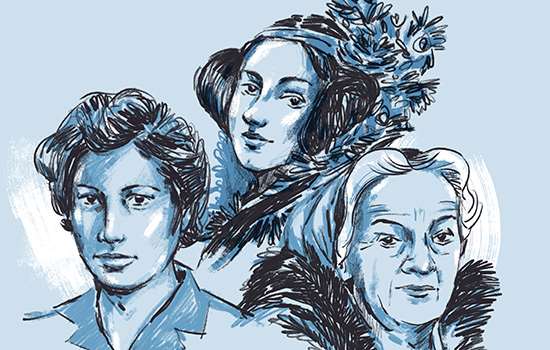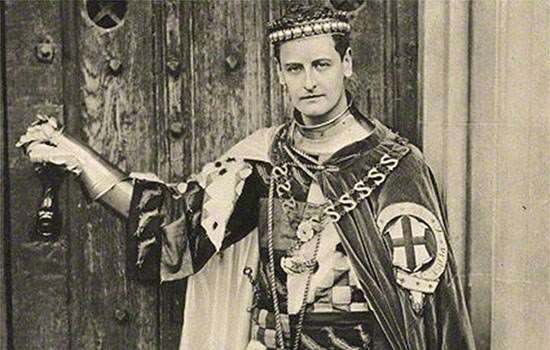Painters
Historically painting was viewed as a male profession, and it was unusual and difficult for women to establish themselves as working painters. However, some managed to break the mould and forge successful careers, supporting their families and paving the way for others to follow.
Mary Beale (1633–99) is often seen as the first professional female artist. At the height of her career in the 1660s, she was in considerable demand and her work was praised by the court painter Sir Peter Lely. She was the main financial supporter of her family, and her husband Charles became her studio manager while her youngest son followed in her footsteps, becoming a miniature painter. Beale’s painting of Henry Cavendish, 2nd Duke of Newcastle, hangs at Kenilworth Castle, Warwickshire.
Although there were no full female members of the Royal Academy of Arts until 1922, there were two female founders – Angelica Kauffman and Mary Moser. As well as being an accomplished portrait and landscape painter, Swiss-born Kauffman (1741–1807) favoured historical and allegorical scenes, and often included self-portraits within her work.
One of these, The Artist in the Character of Design Listening to the Inspiration of Poetry, is displayed at Kenwood in north London.
Margaret Carpenter (1793–1872) had a successful career as a painter, at a time when it was extremely difficult for a woman to pursue a career as a professional artist. She had shown early talent and developed a successful career, winning medals at the Society of Arts. It is almost certain that she was a pupil of Sir Thomas Lawrence, and was seen by many as his successor.
Two of her paintings are displayed at Brodsworth Hall, South Yorkshire, including a portrait of Georgiana Thellusson costing 35 guineas, which was roughly the equivalent of 183 day’s wages for a skilled tradesman at the time (and almost £3,000 in today’s money). Georgiana was the wife of the builder of the hall, Charles Sabine Augustus Thellusson. Carpenter’s portrait of Georgiana’s sister, Frances, also hangs at the hall.
Sculptors
Sculptures adorn many of our sites, whether outdoor garden sculpture or small and exquisitely detailed architectural carvings. Although most of the sculptures we care for are by male artists, within the object collections at English Heritage are examples of work by trailblazing women sculptors.
At the time Anne Seymour Damer (1748–1828) was producing work, it was very unusual for a woman to be a sculptor – a profession that requires both physical strength and artistic flair. Damer showed works at the Royal Academy as an honorary exhibitor, and her subjects included King George III. Her godfather Horace Walpole described her work as ‘not inferior to the antique’. Damer’s terracotta sculpture of Caroline, Princess of Wales, can be seen at Ranger’s House, south-east London.
Internationally important French painter Rosa Bonheur (1822–99) was also a noted sculptor, who specialised in animals. One of her bronze sculptures, a bull, can be seen at Brodsworth Hall. Bonheur was an unusual character in many ways. Her quest for anatomical detail led her to acquire a police permit to wear men’s clothing in public, in order to better equip her for visits to slaughterhouses and cattle markets. While it is difficult to retrospectively analyse her personal life, we know that she had two significant and long-lasting relationships with women, famously stating that ‘As far as males go, I only like the bulls I paint.’
Alongside portrait paintings, sculpture was a popular way of capturing the likeness of a loved one. Mary Thornycroft (1809–95) was a favourite sculptor of Queen Victoria, and worked for the royal family for many years. Thornycroft’s marble sculptures of the royal children, including the limbs of the young princesses and princes (based on plaster casts taken when the children were sleeping), are on display at Osborne House on the Isle of Wight. Trained by her father, the sculptor John Francis, Thornycroft herself taught Queen Victoria’s daughter Princess Louise the art of sculpting.
Amateur artists
While the artists mentioned above were highly accomplished professionals, not all of the objects in our care were intended for public view. Many of the artworks created were highly personal, intended for family and friends. This is particularly true of works of art in our country houses, where girls were expected to develop their skills in a number of different crafts such as art, embroidery and music.
The elder daughter of Charles Sabine and Georgiana Thellusson, Aline Thellusson (1856–1880) would have been seven when the family moved to Brodsworth Hall. Although she suffered from ill health, she was able to exercise her artistic talents, as several paintings at Brodsworth bear her signature. Aline often copied other paintings (including ones by masters such as Sir Edwin Landseer) or photographs of family pets. In a quiz she devised for her close family, one of her questions asked them to name their favourite painter.
Room interiors were a popular subject matter for painting. As rooms were often changed and redecorated by later generations such amateur paintings are an important record of earlier decorative schemes. At Audley End House in Essex, an album of watercolours from the 1840–50s can be attributed to the 3rd Lord Braybrooke’s daughters Louisa or Lucy Neville. The album contains an image of the nursery, which helped to ensure accuracy when the room was restored in 2014.
Royalty can also be counted among the talented and enthusiastic amateur artists whose work you can explore when visiting our sites. At Osborne examples of work by Queen Victoria and her daughters Princesses Louise, Alice, Victoria and Helena are displayed. A painting by Queen Victoria exhibited in her dressing room depicts Annie Macdonald, the daughter of a huntsman on the Balmoral estate in Scotland. The painting was described by the Queen in her journal as being ‘really […] quite successful’.
Artists with a blue plaque
In 1986 English Heritage took over the London blue plaques scheme, which commemorates prominent individuals at the buildings where they lived or worked. Four blue plaques feature women artists: an illustrator, painter, wax sculptor and textile designer all represent the range and development of art in London.
Known for her children’s book illustrations, artist and writer Kate Greenaway (1846–1901) features on a plaque at her former home and studio. Greenaway’s captivating designs, including those for Robert Browning’s The Pied Piper of Hamelin (published 1888), firmly established her as one of the best-loved early children’s illustrators.
Described as an ‘artist in wax’, Madame Marie Tussaud (1761–1850), sculptor and art tutor to the French nobility, moved to Britain in 1802 to tour her collection of wax sculptures. Tussaud was a businesswoman as well as an artist, and her legacy continues today with the famous wax museum that bears her name.
Evelyn de Morgan (1855–1919) was one of the first three women to study at the newly formed Slade School of Art. De Morgan (née Pickering) won several scholarships and awards for her work. Her paintings reflect her unique allegorical style, which was influenced by Pre-Raphaelite and Renaissance work.
Anna Maria Garthwaite (1690–1763) is notable as the first woman textile designer to establish herself in Spitalfields, the home of London’s silk weaving trade. Many of Garthwaite’s original floral watercolour designs survive as a testament to her creativity and business flair. Her blue plaque is sited at her home and workplace, 2 Princelet Street, Spitalfields.
Overall, only 14 per cent of blue plaques celebrate women, and we would like to increase the number of blue plaques which feature women artists. If you know of a woman who deserves a blue plaque and meets the selection criteria, nominate her now and help us address the gender imbalance in London’s blue plaques.
Propose a blue plaqueContemporary artists
Exploring the sites that we care for often involves finding new ways to share the history of the people who lived, worked and inhabited them. We have worked with a variety of contemporary female artists to tell these stories.
Soundscapes are one means in which stories can inhabit spaces. In 2018 we worked with Turner Prize-winning artist Susan Philipsz at Belsay Hall in Northumberland to create a soundscape, The Yellow Wallpaper, which used voice recordings to fill the silent spaces inside the hall. The following year Elaine Mitchener brought together a powerful spoken word installation at Portchester Castle in Hampshire called Les Murs Sont Témoins | These Walls Bear Witness, revealing the hidden stories of French and Caribbean prisoners who were held there during the French Revolutionary and Napoleonic Wars.
The presence of the work of female sculptors in our historic collections has also been continued in the present day. Alison Dale was one of two sculptors commissioned to create a piece responding to a myth associated with Brinkburn Priory in Northumberland. Dale’s sculpture of a bell, made from copper alloy, represents the death of the priory monks when the sounding of the priory bell gave away their position to local raiders.
Most recently, the nationwide exhibition ‘Painting our Past: The African Diaspora in England’ explores the stories of historic figures from the African diaspora who have contributed to the story of England. Five out of the six artists selected to paint these figures were women. These included Glory Samjolly, an Afro-Caribbean and multidisciplinary artist who also developed the social enterprise Black Aristocratic Art in 2019. Her portrait focused on James Chappell, a black servant in the household of Christopher Hatton, the owner of Kirby Hall near the village of Gretton, Northamptonshire. Samjolly’s interpretation inverts Chappell’s status as a servant and portrays him as an aristocrat in costume, expression and setting. The other artists are Chloe Cox, Mikéla Henry-Lowe, Elena Onwochei-Garcia, Clifton Powell and Hannah Uzor.
Written by Eleanor Matthews
Top image: Detail from Angelica Kauffman’s painting The Artist in the Character of Design Listening to the Inspiration of Poetry, which hangs at Kenwood
To read more about female artists in history, please also see the Women Artists trail on Royal Collection Trust’s website.
Explore More
-

WOMEN IN HISTORY
Read about the remarkable lives of some of the women who have left their mark on society and shaped our way of life – from Anglo-Saxon times to the 20th century.
-

LGBTQ+ History
LGBTQ+ history has often been hidden from view. Find out more about the lives of some LGBTQ+ individuals and their place in the stories of English Heritage sites.
-

Pioneering Women
Find out more about the pioneering figures who fought to open up new opportunities for women, and who are now commemorated by the blue plaques scheme.
